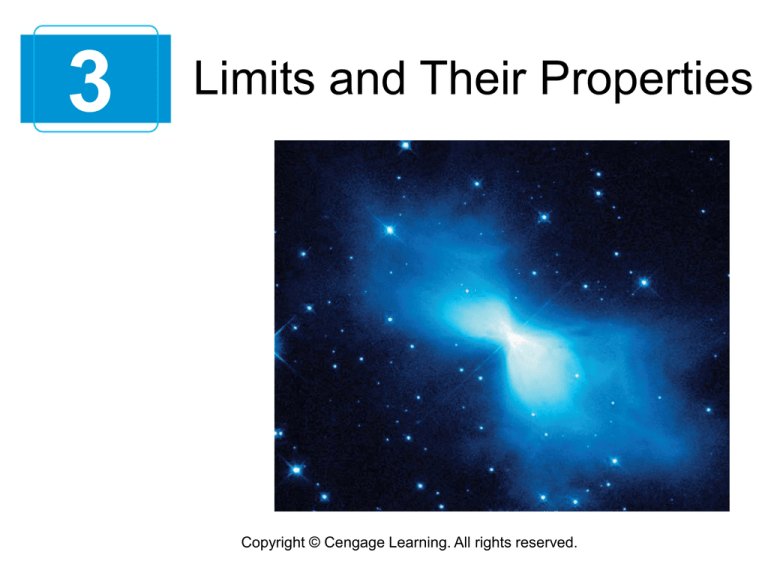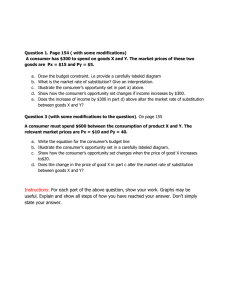
3
Limits and Their Properties
Copyright © Cengage Learning. All rights reserved.
3.3
Evaluating Limits Analytically
Copyright © Cengage Learning. All rights reserved.
Properties of Limits
We have learned that the limit of f(x) as x approaches c
does not depend on the value of f at x = c. It may happen,
however, that the limit is precisely f(c). In such cases, the
limit can be evaluated by direct substitution. That is,
Substitute c for x.
Such well-behaved functions are continuous at c.
3
Properties of Limits
In Example 2, note that the limit (as x → 2) of the
polynomial function p(x) = 4x2 + 3 is simply the value of p at
x = 2.
This direct substitution property is valid for all polynomial
and rational functions with nonzero denominators.
4
A Strategy for Finding Limits
5
Example 5 – Solution
Because
cont’d
exists, you can apply Theorem 3.6 to
conclude that f and g have the same limit at x = 1.
Factor.
Divide out like factors.
Apply Theorem 3.6.
Use direct substitution.
Simplify.
6
Example 5 – Solution
cont’d
So, for all x-values other than x = 1, the functions f and g
agree, as shown in Figure 3.15.
f and g agree at all but one point.
Figure 3.15
7
A Strategy for Finding Limits
8
Dividing Out and Rationalizing
Techniques
9
Dividing Out and Rationalizing Techniques
Two techniques for finding limits analytically are shown in
Examples 6 and 7.
The dividing out technique involves dividing out common
factors, and the rationalizing technique involves
rationalizing the numerator of a fractional expression.
10
Example 6 – Dividing Out Technique
Find the limit:
Solution:
Although you are taking the limit of a rational function, you
cannot apply Theorem 3.3 because the limit of the
denominator is 0.
Direct substitution fails.
11
Example 6 – Solution
cont’d
Because the limit of the numerator is also 0, the numerator
and denominator have a common factor of (x + 3).
So, for all x –3 you can divide out this factor to obtain
12
Example 6 – Solution
cont’d
Using Theorem 3.6, it follows that
Apply Theorem 3.6.
Use direct substitution.
This result is shown graphically in
Figure 3.16.
Note that the graph of the function
f coincides with the graph of the
function g(x) = x – 2, except that
the graph of f has a gap at the
point (–3, –5).
f is undefined when x = –3
Figure 3.16
13
Dividing Out and Rationalizing Techniques
In Example 6, direct substitution produced the meaningless
fractional form 0/0.
An expression such as 0/0 is called an indeterminate form
because you cannot (from the form alone) determine the
limit. When you try to evaluate a limit and encounter this
form, remember that you must rewrite the fraction so that
the new denominator does not have 0 as its limit.
One way to do this is to divide out common factors, as
shown in Example 7. A second way is to rationalize the
numerator, as shown in Example 7.
14
Example 7 – Rationalizing Technique
Find the limit:
Solution:
By direct substitution, you obtain the indeterminate form
0/0.
Direct substitution fails.
15
Example 7 – Solution
cont’d
In this case, you can rewrite the fraction by rationalizing the
numerator.
16
Example 7 – Solution
cont’d
Now, using Theorem 3.6, you can evaluate the limit as
shown.
17
Example 7 – Solution
cont’d
A table or a graph can reinforce your conclusion that the
limit is (See Figure 3.18.)
The limit of f(x) as x approaches 0 is
Figure 3.18
18







